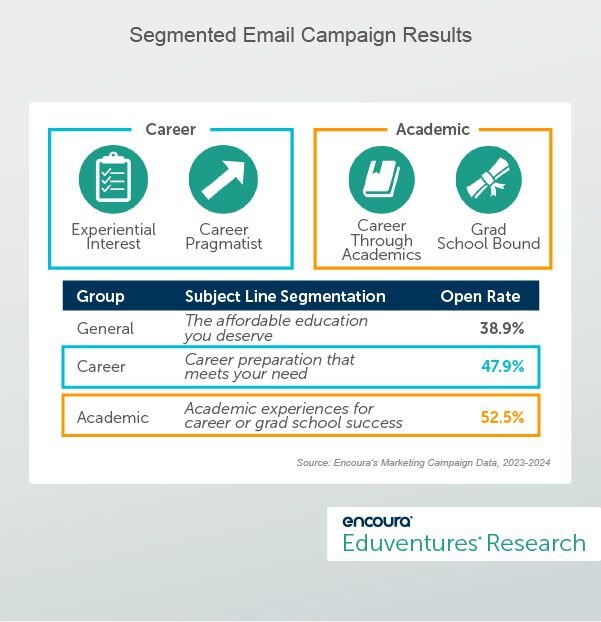Email open-rates among college-bound high school students are dropping. As recruiting emails reach fewer students compared to previous cycles, many institutions are doubling down with increased campaign frequency, sometimes with daily emails. The hope they are betting on: greater visibility will lead to greater name recognition and, ultimately, greater engagement.
But does it? Student comments from our Student Sentiment Research™ often mention feeling overwhelmed with the volume of emails, while many institutions report positive effects from the practice, including increased applications.
When it comes to recruitment emails, is it “less is more,” or “the more the merrier?”
What Is the Right Cadence?
Striking the delicate balance between emailing prospective students enough to stay top of mind but not so much that it causes annoyance is indeed a question on the minds of marketers. But this balance is difficult to achieve. Figure 1 shows that even students don’t agree on the right cadence.
Figure 1.
Figure 1 shows how often college-bound high school students say they would like to hear from institutions on a variety of topics. Some subtle differences can be seen by topic. For instance, students would like to hear more often about campus events but less often about cost and financial aid. Overall, however, it shows that desired frequency varies widely.
No matter what topic, about two-thirds of students don’t want to hear from schools more than bi-weekly. While many institutions report a positive impact of daily emails on applications and yield—although it can be difficult to directly attribute this success to one specific effort among many—the longer-term risk is the possibility of jeopardizing brand equity.
Additionally, the pressure of creating daily email content often comes at the cost of originality and necessitates repetitiveness—the very things many students say they dislike about recruitment emails.
To explore whether your institution is a good candidate for daily outreach—or whether you should scale back—pay close attention to your campaign metrics. If you work with an agency, it may already do this for you, but it’s best not to assume.
Open rates are only one metric, and with advancing AI bots and SPAM filter measures, an imperfect one. Be careful not to count opens from K-12 email domains that often indicate inflated open and click rates due to software used by many school districts that impersonates email opening. Instead, work on ways to filter out immediate opens and multiple email clicks that often represent an email system testing the validity of your content.
Other metrics that indicate actions taken, including unsubscribes, can give you a better sense of whether your emails are resonating. Touchpoint mapping, or journey mapping, which analyzes every digital interaction a student has with your institution, from opening emails to visiting your social presence and beyond, also provides a more comprehensive understanding of engagement.
Tell Them Before They Have to Ask
Perhaps even more important than the right cadence, institutional marketers should consider what will prompt a student to open an email in an overflowing inbox.
“I liked how descriptive the email was. I also liked how personal the email was.” - College-bound high school junior, Student Sentiment Research 2024
As this representative comment suggests, students will open emails that contain information that is relevant to their interests, in other words, emails that are effectively personalized.
But personalization at scale can be difficult. Institutions need to collect many data points on each prospect, record this information in their CRMs, and build communication flows around it all. Developing communication flows on a multitude of topics and interests is even more challenging.
Encoura’s proven approach is to design email campaigns around Eduventures’ Prospective Student Mindsets™ (Mindsets). This segmentation technique allows institutions to address the key questions on students’ minds in an organized way. More importantly, small changes like imagery, the order of content, or even the subject lines can make a great impact (see Figure 2).
Figure 2.
Figure 2 shows the results of an institutional email campaign designed by Encoura’s Enrollment Marketing Services team. A/B testing was conducted to test the efficacy of Mindset-specific subject lines against a general subject line (“The affordable education you deserve”).
To further simplify the campaign, the same subject line was used for groups of two adjacent Mindsets: Experiential Interest and Career Pragmatist students received a subject line addressing their interests in career preparation (“Career preparation that meets your needs”), while Career Through Academics and Grad School Bound students saw a subject line aimed to appeal to their foci on academics (“Academic experiences for career or grad school success”).
Consistently, subject lines that address key priorities of the target Mindset perform better than a general subject line. In this case, these personalized subject lines also addressed a particularly top-of-mind topic: affordability. The open rates for the subject line used for career-focused Mindsets were 9% higher than those of the general subject line, and the academics-focused subject line performed even better with a 13% higher open rate.
Small, efficient changes can have a big impact but require a thoughtful approach— something that marketers may not have time for if tasked with daily email campaigns.
The Bottom Line
While some institutions report successes with daily email campaigns, this is likely not a one-size-fits-all approach. It’s important not to ignore the student voices overwhelmed with overflowing inboxes of generic email content. But student attitudes should not be the primary litmus test. Institutions need to pay close attention to their campaign performance metrics. If needed, adjust not only the frequency but also review whether your content can be improved:
- Understand which metrics matter: Open rates, while not perfect, can give you a general understanding of your campaign performance. Unsubscribe rates often provide a better understanding of quality engagement. Touchpoint mapping, while the most resource-intensive method, will give you the best data on whether your email campaigns are effective.
- Be mindful of funnel stage: Most student complaints center on email communication from institutions in which these students have no interest. Once you have an established relationship with your prospect—that is, they took an action after receiving your email—students are typically more open to more frequent communications. At this stage, the relationship development content should complement task-oriented to-do lists and reminders to get students through the final steps.
- Understand your competitive advantages: Students don’t want to see the same content from multiple institutions. But while you put in the extra effort to personalize your content, also consider what your institutional identity is and how it differs from your peers and competitors. What are your institutional strengths? What types of students do you serve best?
- Start with small changes: Not all your campaigns need to be segmented, and not all your creative needs to be overhauled immediately. Perhaps start with existing images and content that merely needs to be rearranged and sent in more strategic intervals.

Gain a deeper understanding of why your admitted students are enrolling–or not enrolling–at your institution to tailor your marketing and recruiting strategies.



